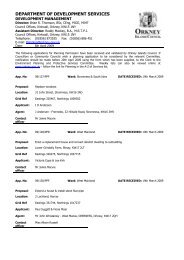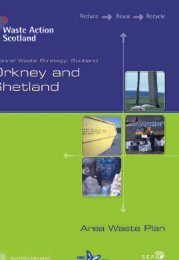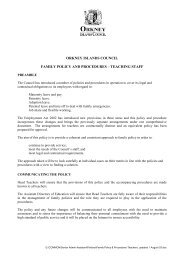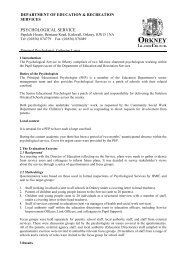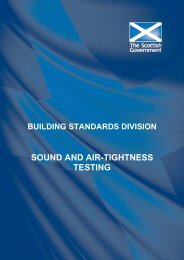The Heart of Neolithic Orkney World_Heritage Site Supplementary ...
The Heart of Neolithic Orkney World_Heritage Site Supplementary ...
The Heart of Neolithic Orkney World_Heritage Site Supplementary ...
You also want an ePaper? Increase the reach of your titles
YUMPU automatically turns print PDFs into web optimized ePapers that Google loves.
<strong>Orkney</strong> Islands Council<br />
<strong>The</strong> <strong>Heart</strong> <strong>of</strong> <strong>Neolithic</strong> <strong>Orkney</strong><br />
<strong>World</strong> <strong>Heritage</strong> <strong>Site</strong><br />
<strong>Supplementary</strong> Planning Guidance<br />
7 December 2010<br />
Image courtesy <strong>of</strong> Craig Taylor
THE HEART OF NEOLITHIC ORKNEY WORLD HERITAGE SITE SPG • 7 DECEMBER 2010<br />
ORKNEY ISLANDS COUNCIL<br />
SECTION 1<br />
<strong>The</strong> Purpose <strong>of</strong> the <strong>Supplementary</strong> Planning Guidance<br />
<strong>The</strong> purpose <strong>of</strong> this <strong>Supplementary</strong> Planning Guidance<br />
(SPG) is to establish a detailed policy context for<br />
managing the impact <strong>of</strong> land use planning decisions<br />
on the Outstanding Universal Value <strong>of</strong> the <strong>Heart</strong> <strong>of</strong><br />
<strong>Neolithic</strong> <strong>Orkney</strong> <strong>World</strong> <strong>Heritage</strong> <strong>Site</strong>. <strong>The</strong> scope <strong>of</strong><br />
the SPG includes issues associated with the component<br />
sites themselves and their wider setting.<br />
<strong>The</strong> SPG will deliver a key Aim <strong>of</strong> the <strong>Heart</strong> <strong>of</strong><br />
<strong>Neolithic</strong> <strong>Orkney</strong> <strong>World</strong> <strong>Heritage</strong> <strong>Site</strong> Management<br />
Plan 2008-13 in terms <strong>of</strong> updating the existing<br />
development plan policy to improve clarity at an early<br />
stage taking cognisance <strong>of</strong> the Management Plan and<br />
recent expert studies. A Main Issues Report has been<br />
published as part <strong>of</strong> the <strong>Orkney</strong> Local Development<br />
Plan Review process (20 November 2009). This notifies<br />
<strong>of</strong> the intention to establish a fresh policy within the<br />
new Local Development Plan relating to the <strong>World</strong><br />
<strong>Heritage</strong> <strong>Site</strong> (WHS). This policy will establish a<br />
general commitment to preserving the integrity and<br />
authenticity <strong>of</strong> the WHS. It will also seek to manage<br />
the impact <strong>of</strong> development on the wider setting <strong>of</strong><br />
the WHS, and prevent development which would<br />
have a significant adverse impact on its Outstanding<br />
Universal Value.<br />
<strong>The</strong> Main Issues Report specifies that <strong>Supplementary</strong><br />
Guidance will be prepared as part <strong>of</strong> the Local<br />
Development Plan to provide greater detail on the<br />
policy issues. This SPG is intended to be the first stage<br />
in this process. It is intended that this SPG will<br />
ultimately be adopted as statutory supplementary<br />
guidance and become part <strong>of</strong> the Local Development<br />
Plan in due course.<br />
<strong>The</strong> overall objective <strong>of</strong> this SPG is tw<strong>of</strong>old:<br />
1) To ensure that high quality development, which is<br />
sympathetic and appropriate to the WHS and its<br />
setting can occur.<br />
2) To ensure that development which will have a<br />
significant adverse impact on the Outstanding<br />
Universal Value <strong>of</strong> the <strong>World</strong> <strong>Heritage</strong> <strong>Site</strong> or its<br />
setting does not occur.<br />
<strong>Orkney</strong> Islands Council<br />
1
THE HEART OF NEOLITHIC ORKNEY WORLD HERITAGE SITE SPG • 7 DECEMBER 2010<br />
ORKNEY ISLANDS COUNCIL<br />
SECTION 2<br />
Background<br />
<strong>Site</strong>s are inscribed onto the <strong>World</strong><br />
<strong>Heritage</strong> List by UNESCO<br />
following their successful<br />
nomination by a state party under<br />
the auspices <strong>of</strong> the Convention<br />
Concerning the Protection <strong>of</strong> the<br />
<strong>World</strong> Cultural and Natural<br />
<strong>Heritage</strong> 1972 (<strong>World</strong> <strong>Heritage</strong><br />
Convention), ratified by the UK<br />
Government in 1984. To be successful, a nomination<br />
dossier must demonstrate that a particular site is <strong>of</strong><br />
Outstanding Universal Value.<br />
Although the UK Government is responsible for<br />
ensuring that the terms <strong>of</strong> the Convention are met,<br />
both the Scottish Government and Local Authorities<br />
have key roles to play in realising the Convention’s<br />
aims. No additional statutory controls result from<br />
<strong>World</strong> <strong>Heritage</strong> designation. However, national<br />
guidance requires that specific policy, for example<br />
through a Local Development<br />
Plan or <strong>Supplementary</strong> Planning<br />
Guidance, should be established<br />
to assist Planning Authorities to<br />
fulfil their roll in managing<br />
development both within the<br />
sites themselves and also within<br />
the wider setting <strong>of</strong> the sites.<br />
Scottish Ministers have identified the historic<br />
environment as one <strong>of</strong> Scotland’s greatest economic,<br />
cultural and social assets and stress the importance<br />
that they place upon this finite resource as part <strong>of</strong> the<br />
nation’s identity. Whilst this SPG seeks to safeguard<br />
the Outstanding Universal Value <strong>of</strong> the <strong>Heart</strong> <strong>of</strong><br />
<strong>Neolithic</strong> <strong>Orkney</strong> <strong>World</strong> <strong>Heritage</strong> <strong>Site</strong>, it does not seek<br />
to stifle change or to restrict progress unnecessarily.<br />
Rather, it is the aim <strong>of</strong> this document to ensure that<br />
high quality development is delivered in a<br />
sympathetic and appropriate manner.<br />
Image courtesy <strong>of</strong> Craig Taylor<br />
<strong>Orkney</strong> Islands Council<br />
2
THE HEART OF NEOLITHIC ORKNEY WORLD HERITAGE SITE SPG • 7 DECEMBER 2010<br />
ORKNEY ISLANDS COUNCIL<br />
SECTION 3<br />
<strong>The</strong> <strong>Heart</strong> <strong>of</strong> <strong>Neolithic</strong> <strong>Orkney</strong> <strong>World</strong> <strong>Heritage</strong> <strong>Site</strong><br />
<strong>The</strong> <strong>Heart</strong> <strong>of</strong> <strong>Neolithic</strong> <strong>Orkney</strong> <strong>World</strong> <strong>Heritage</strong> <strong>Site</strong><br />
comprises six individual component sites, each <strong>of</strong><br />
which are Scheduled Monuments: the settlement <strong>of</strong><br />
Skara Brae, Maeshowe, the Stones <strong>of</strong> Stenness, the<br />
Watch Stone, the Barnhouse Stone, and the Ring <strong>of</strong><br />
Brodgar and its associated ritual and funerary<br />
monuments. <strong>The</strong> <strong>Heart</strong> <strong>of</strong> <strong>Neolithic</strong> <strong>Orkney</strong> <strong>World</strong><br />
<strong>Heritage</strong> <strong>Site</strong> was formally inscribed onto the <strong>World</strong><br />
<strong>Heritage</strong> List on 2 December 1999 as a group <strong>of</strong> sites<br />
deemed to be an outstanding testimony to the<br />
cultural achievements <strong>of</strong> the <strong>Neolithic</strong> peoples <strong>of</strong><br />
Northern Europe, fulfilling four <strong>of</strong> the six criteria <strong>of</strong><br />
Outstanding Universal Value for cultural sites as<br />
outlined below:<br />
Criterion (i): represent a masterpiece <strong>of</strong> human<br />
creative genius<br />
Maeshowe is an exceptionally<br />
early architectural<br />
accomplishment, which, together<br />
with the visually interconnected<br />
Stones <strong>of</strong> Stenness and the Ring<br />
<strong>of</strong> Brodgar, represent a<br />
masterpiece <strong>of</strong> human creative<br />
genius. <strong>The</strong> major monuments<br />
that make up the <strong>World</strong> <strong>Heritage</strong><br />
<strong>Site</strong> display the highest<br />
sophistication in conception,<br />
design and execution.<br />
Criterion (ii): exhibit an<br />
important interchange <strong>of</strong> human<br />
values, over a span <strong>of</strong> time or<br />
within a cultural area <strong>of</strong> the<br />
world, on developments in<br />
architecture or technology,<br />
monumental arts, townplanning<br />
or landscape design<br />
<strong>The</strong> <strong>World</strong> <strong>Heritage</strong> <strong>Site</strong> exhibits<br />
an important interchange <strong>of</strong><br />
human values during the<br />
development <strong>of</strong> the architecture<br />
<strong>of</strong> major ceremonial complexes<br />
in the British Isles, Ireland and<br />
north-west Europe<br />
Criterion (iii): bear a unique or at<br />
least exceptional testimony to a<br />
cultural tradition or to a<br />
civilization which is living or<br />
which has disappeared<br />
Through the combination <strong>of</strong><br />
ceremonial, funerary and<br />
domestic sites, the <strong>World</strong><br />
<strong>Heritage</strong> <strong>Site</strong> bears a unique<br />
testimony to a cultural tradition<br />
which flourished between about<br />
3000 BC and 2000 BC. <strong>The</strong> state<br />
<strong>of</strong> preservation <strong>of</strong> Skara Brae is<br />
without parallel amongst<br />
<strong>Neolithic</strong> settlement sites<br />
<strong>Orkney</strong> Islands Council<br />
3
THE HEART OF NEOLITHIC ORKNEY WORLD HERITAGE SITE SPG • 7 DECEMBER 2010<br />
ORKNEY ISLANDS COUNCIL<br />
Criterion (iv): be an outstanding example <strong>of</strong> a type<br />
<strong>of</strong> building or architectural or technological<br />
ensemble or landscape which illustrates (a)<br />
significant stage(s) in human history<br />
<strong>The</strong> <strong>World</strong> <strong>Heritage</strong> <strong>Site</strong> is an outstanding example<br />
<strong>of</strong> an architectural ensemble and archaeological<br />
landscape which illustrate a significant stage <strong>of</strong><br />
human history, that is, when the first large<br />
ceremonial monuments were built.<br />
<strong>The</strong> <strong>Neolithic</strong> represents arguably the most<br />
fundamental period <strong>of</strong> change to occur within the<br />
history <strong>of</strong> human society, it marks the end <strong>of</strong><br />
humanity’s reliance upon solely hunting and<br />
gathering foodstuffs and sees the origins <strong>of</strong><br />
farming. <strong>The</strong> period is characterised by the first<br />
major instances <strong>of</strong> land clearance, the demarcation<br />
<strong>of</strong> distinct territories, fixed settlements and<br />
monumental architecture.<br />
<strong>The</strong> <strong>Heart</strong> <strong>of</strong> <strong>Neolithic</strong> <strong>Orkney</strong> <strong>World</strong> <strong>Heritage</strong> <strong>Site</strong> is<br />
the smallest and most closely defined WHS in the UK.<br />
<strong>The</strong> WHS is concentrated in two distinct geographical<br />
centres with Skara Brae located on the northwest<br />
coast <strong>of</strong> the West Mainland and the remaining<br />
monuments sited some five miles to the southeast.<br />
<strong>The</strong> WHS does not exist in isolation and studies have<br />
shown that one <strong>of</strong> the defining aspects <strong>of</strong> the <strong>Heart</strong><br />
<strong>of</strong> <strong>Neolithic</strong> <strong>Orkney</strong> <strong>World</strong> <strong>Heritage</strong> <strong>Site</strong> is its<br />
topographical, archaeological, perceptual and<br />
experiential relationships with the surrounding<br />
physical and archaeological landscapes. With the<br />
exception <strong>of</strong> Skara Brae, the WHS lies within a large,<br />
open, loch basin. This landscape is one <strong>of</strong> the most<br />
sensitive in Scotland, forming part <strong>of</strong> a National<br />
Scenic Area and comprising the setting for this<br />
collection <strong>of</strong> internationally significant monuments.<br />
Further explanation <strong>of</strong> this issue can be found in<br />
Section 4 (below).<br />
<strong>The</strong> scope <strong>of</strong> this SPG is therefore intentionally wider<br />
than the actual extent <strong>of</strong> the formal WHS boundary.<br />
It encompasses the wider setting which evidence<br />
suggests is critically significant to the Outstanding<br />
Universal Value <strong>of</strong> the WHS. It is therefore a<br />
legitimate concern <strong>of</strong> the land use planning system<br />
to seek to manage the impact <strong>of</strong> new development<br />
within this wider setting/land area.<br />
<strong>Orkney</strong> Islands Council<br />
4
THE HEART OF NEOLITHIC ORKNEY WORLD HERITAGE SITE SPG • 7 DECEMBER 2010<br />
ORKNEY ISLANDS COUNCIL<br />
SECTION 4<br />
<strong>The</strong> Setting <strong>of</strong> the <strong>World</strong> <strong>Heritage</strong> <strong>Site</strong><br />
Though no additional statutory controls result from<br />
<strong>World</strong> <strong>Heritage</strong> designation, Scottish Planning<br />
Policy requires that planning authorities protect<br />
WHS and their settings from inappropriate<br />
development by including relevant policies in the<br />
Development Plan, which set out the factors that<br />
will be taken into account when deciding<br />
applications for development proposals which may<br />
impact on a WHS. <strong>The</strong>se policies must ensure that<br />
the immediate setting <strong>of</strong> a WHS, important views,<br />
and other areas which are important to the site and<br />
its protection, be protected from inappropriate<br />
development. In addition to this, the setting <strong>of</strong> all<br />
scheduled monuments is a material consideration<br />
for local authorities when determining applications<br />
for planning permission and in all cases where a<br />
proposed development may impact upon the<br />
setting <strong>of</strong> a scheduled monument, Historic Scotland<br />
must be consulted.<br />
Scottish Planning Policy and the Scottish Historic<br />
Environment Policy emphasise that setting is more<br />
than simply the immediate surroundings <strong>of</strong> a site. It<br />
can also relate to how the site was intended to fit<br />
into the landscape, the views from it and how the<br />
site is seen from the surrounding area.<br />
<strong>The</strong> Statement <strong>of</strong> Outstanding Universal Value set<br />
out in the <strong>Heart</strong> <strong>of</strong> <strong>Neolithic</strong> <strong>Orkney</strong> <strong>World</strong> <strong>Heritage</strong><br />
<strong>Site</strong> Management Plan, as submitted to the <strong>World</strong><br />
<strong>Heritage</strong> Committee for approval in 2008, states that:<br />
“<strong>The</strong> relationships between the <strong>World</strong> <strong>Heritage</strong><br />
<strong>Site</strong> and the wider physical<br />
landscape are critical to<br />
understanding the<br />
monuments and the<br />
intentions <strong>of</strong> their<br />
builders; and hence form<br />
part <strong>of</strong> the Outstanding<br />
Universal Value <strong>of</strong> the<br />
<strong>World</strong> <strong>Heritage</strong> <strong>Site</strong>.”<br />
With the exception <strong>of</strong> Skara<br />
Brae, it appears to be clear<br />
that the wider setting <strong>of</strong> the<br />
monuments comprising the<br />
WHS was indeed integral to<br />
their construction, it being<br />
inconceivable that their<br />
positioning was either<br />
accidental or incidental.<br />
Henge monuments<br />
throughout the UK are<br />
<strong>of</strong>ten located in large<br />
natural topographical<br />
bowls and are generally sited between rivers, lakes<br />
or lochs. Furthermore, Maeshowe is intentionally<br />
aligned in such a manner that on midwinter, the<br />
sunlight from the setting sun shines directly along<br />
the entrance passage to light the main chamber<br />
within. Not only does this phenomenon suggest that<br />
considerable thought and<br />
planning went into the siting<br />
<strong>of</strong> the monument, the fact<br />
that the midwinter sun sets<br />
behind the imposing Hoy hills<br />
to the southwest demonstrates<br />
that the surrounding landscape<br />
was also a consideration <strong>of</strong> the<br />
architects.<br />
Whilst it is accepted that the<br />
siting <strong>of</strong> Skara Brae and its links<br />
to the wider landscape are not<br />
as fundamentally important as<br />
at Brodgar, and that its ‘Inner<br />
Sensitive Zone’ has a differing<br />
values and characteristics than<br />
that at its counterpart,<br />
applications for planning<br />
permission will be assessed<br />
utilising the same methodology<br />
to determine whether the<br />
Outstanding Universal Value <strong>of</strong><br />
the site will be adversely affected.<br />
<strong>Orkney</strong> Islands Council<br />
5
THE HEART OF NEOLITHIC ORKNEY WORLD HERITAGE SITE SPG • 7 DECEMBER 2010<br />
ORKNEY ISLANDS COUNCIL<br />
SECTION 5<br />
Outstanding Universal Value<br />
UNESCO states that cultural heritage is a priceless<br />
and irreplaceable asset, not only <strong>of</strong> a particular<br />
nation, but <strong>of</strong> humanity as a whole. Particular<br />
elements <strong>of</strong> that heritage, where it can be<br />
demonstrated that the exceptional qualities <strong>of</strong><br />
which are <strong>of</strong> Outstanding Universal Value, are<br />
inscribed upon the <strong>World</strong> <strong>Heritage</strong> List. Outstanding<br />
Universal Value is defined by UNESCO within their<br />
Operational Guidelines for the Implementation <strong>of</strong><br />
the <strong>World</strong> <strong>Heritage</strong> Convention as:<br />
“Cultural significance which is so exceptional as<br />
to transcend national boundaries and to be <strong>of</strong><br />
common importance for present and future<br />
generations <strong>of</strong> all humanity. As such, the<br />
permanent protection <strong>of</strong> this heritage is <strong>of</strong> the<br />
highest importance to the<br />
international community<br />
as a whole.”<br />
<strong>of</strong> <strong>Neolithic</strong> <strong>Orkney</strong> <strong>World</strong> <strong>Heritage</strong> <strong>Site</strong> and to<br />
ensure that any proposed developments are carried<br />
out in a sympathetic and appropriate manner.<br />
UNESCO emphasise that the authenticity and<br />
integrity <strong>of</strong> a WHS is critical to its Outstanding<br />
Universal Value and that the values evident at the<br />
time <strong>of</strong> inscription should be maintained or<br />
enhanced in the future. In assessing whether or not<br />
a potential development will have a significant<br />
adverse impact upon the Outstanding Universal<br />
Value <strong>of</strong> the WHS, as defined within the criterion<br />
detailed at Section 3 above and the most up to date<br />
Statement <strong>of</strong> Outstanding Universal Value, it must<br />
be established whether or not the proposal<br />
compromises the authenticity or integrity <strong>of</strong> the<br />
WHS or its setting.<br />
<strong>The</strong> current Statement <strong>of</strong><br />
Outstanding Universal Value<br />
can be found within the<br />
<strong>Heart</strong> <strong>of</strong> <strong>Neolithic</strong> <strong>Orkney</strong><br />
<strong>World</strong> <strong>Heritage</strong> <strong>Site</strong><br />
Management Plan 2008 -13,<br />
a copy <strong>of</strong> which can be found<br />
at Appendix 1 <strong>of</strong> this<br />
document. This SPG seeks to<br />
preserve the Outstanding<br />
Universal Value <strong>of</strong> the <strong>Heart</strong><br />
Image courtesy <strong>of</strong> Craig Taylor<br />
<strong>Orkney</strong> Islands Council<br />
6
THE HEART OF NEOLITHIC ORKNEY WORLD HERITAGE SITE SPG • 7 DECEMBER 2010<br />
ORKNEY ISLANDS COUNCIL<br />
SECTION 6<br />
<strong>The</strong> Policy<br />
OIC <strong>World</strong> <strong>Heritage</strong> <strong>Site</strong> Planning Policy<br />
In considering applications for planning permission, the<br />
Planning Authority will apply the following policies to ensure<br />
that developments which have the potential to have an<br />
impact upon the Outstanding Universal Value <strong>of</strong> the WHS are<br />
delivered in a sympathetic and appropriate manner:<br />
<strong>World</strong> <strong>Heritage</strong> <strong>Site</strong> Policy A<br />
Inner Sensitive Zones:<br />
<strong>The</strong> immediate setting <strong>of</strong> each <strong>of</strong> the two geographical<br />
centres <strong>of</strong> the <strong>World</strong> <strong>Heritage</strong> <strong>Site</strong> will be demarked by<br />
‘Inner Sensitive Zones’ (fig.1).<br />
All proposed development within the ‘Inner Sensitive Zones’,<br />
identified within figure 1, must preserve or enhance the<br />
Outstanding Universal Value <strong>of</strong> the <strong>World</strong> <strong>Heritage</strong> <strong>Site</strong>.<br />
In order to be granted planning permission within the ‘Inner<br />
Sensitive Zones’, it must be demonstrated that development<br />
will not have a significant negative impact upon either the<br />
Outstanding Universal Value or the setting <strong>of</strong> the <strong>World</strong><br />
<strong>Heritage</strong> <strong>Site</strong>.<br />
<strong>World</strong> <strong>Heritage</strong> <strong>Site</strong> Policy B<br />
<strong>The</strong> Wider Landscape Setting:<br />
<strong>The</strong> wider setting <strong>of</strong> the <strong>World</strong> <strong>Heritage</strong> <strong>Site</strong> contributes<br />
directly to its Outstanding Universal Value. Certain<br />
developments outwith the ‘Inner Sensitive Zones’ therefore<br />
have the potential to have a significant negative impact upon<br />
the Outstanding Universal Value <strong>of</strong> the <strong>World</strong> <strong>Heritage</strong> <strong>Site</strong>,<br />
especially where large scale developments are proposed. Of<br />
particular significance are the ridgelines which frame the<br />
topographical landscape bowl <strong>of</strong> the West Mainland (fig.2).<br />
Where a proposed development either:<br />
a) breaks the skyline at the sensitive ridgelines (fig.2) when<br />
viewed from any <strong>of</strong> the component parts <strong>of</strong> the <strong>World</strong><br />
<strong>Heritage</strong> <strong>Site</strong>; or<br />
b) is to be sited in any other location where, in the opinion <strong>of</strong><br />
the Planning Authority, it has the potential to impact upon<br />
the <strong>World</strong> <strong>Heritage</strong> <strong>Site</strong>,<br />
it will only be granted planning permission when it is<br />
demonstrated that the development will not have a<br />
significant negative impact upon either the Outstanding<br />
Universal Value or the setting <strong>of</strong> the <strong>World</strong> <strong>Heritage</strong> <strong>Site</strong>.<br />
<strong>Orkney</strong> Islands Council<br />
7
THE HEART OF NEOLITHIC ORKNEY WORLD HERITAGE SITE SPG • 7 DECEMBER 2010<br />
ORKNEY ISLANDS COUNCIL<br />
SECTION 7<br />
Design Statements<br />
Sympathetic design is a requirement <strong>of</strong> all proposed<br />
buildings and extensions within the Inner Sensitive<br />
Zones <strong>of</strong> the WHS. Applications for new buildings<br />
which fall to be considered under ‘<strong>World</strong> <strong>Heritage</strong><br />
<strong>Site</strong> Policy A’ must demonstrate through a Design<br />
Statement that they will preserve or enhance the<br />
character and appearance <strong>of</strong> the area and that they<br />
will not have a significant adverse impact upon the<br />
Outstanding Universal Value <strong>of</strong> the WHS. In the case<br />
<strong>of</strong> applications seeking planning permission to<br />
extend existing properties, or seeking to change the<br />
use <strong>of</strong> building or area <strong>of</strong> land, a Design Statement<br />
may also be required. <strong>The</strong> following general<br />
principles apply to the Planning Authority’s<br />
consideration <strong>of</strong> development proposals throughout<br />
<strong>Orkney</strong> but are particularly pertinent within the<br />
Inner Sensitive Zones:<br />
Conversion/Adaptation <strong>of</strong> an existing property<br />
which enhances the setting <strong>of</strong> the WHS is in all cases<br />
preferable to the demolition and replacement <strong>of</strong> an<br />
existing building. Traditional/vernacular buildings<br />
can <strong>of</strong>ten be successfully adapted to new uses and<br />
conversion enables the existing settlement pattern<br />
to be effectively retained;<br />
New Buildings; ; must have regard to the continuity <strong>of</strong><br />
rhythm, scale, mass and outline <strong>of</strong> the existing<br />
settlement pattern and its details, materials, texture<br />
and colour. Where appropriate, development <strong>of</strong><br />
previously developed land and buildings should be<br />
instigated before green field sites;<br />
Extensions/Alterations; must in all cases complement<br />
the existing building. <strong>The</strong> extension should be<br />
subordinate in scale and in a form, which allows the<br />
identity and character <strong>of</strong> the original structure to be<br />
retained, and the impact on the<br />
WHS to remain unchanged.<br />
<strong>The</strong> Design Statement allows applicants to explain<br />
their scheme in a structured way. It is an opportunity<br />
to demonstrate what has been done to appraise the<br />
development in the context <strong>of</strong> the ‘Inner Sensitive<br />
Zones’, and how the design takes account <strong>of</strong> this<br />
sensitively. For the majority <strong>of</strong> applications, the<br />
<strong>Orkney</strong> Islands Council<br />
8
THE HEART OF NEOLITHIC ORKNEY WORLD HERITAGE SITE SPG • 7 DECEMBER 2010<br />
ORKNEY ISLANDS COUNCIL<br />
Design Statement does not need to be unnecessarily<br />
elaborate and may be relatively short. In all cases, it<br />
should be a concise document, which sets out the<br />
principles upon which the development is based,<br />
explains how the design preserves or enhances the<br />
character and appearance <strong>of</strong> the ‘Inner Sensitive<br />
Zones’ and shows the consideration that has been<br />
given to any potential impact upon the Outstanding<br />
Universal Value <strong>of</strong> the WHS. Irrespective <strong>of</strong> the scale<br />
<strong>of</strong> the development, the Design Statement should<br />
be supplemented by supporting graphics in the form<br />
<strong>of</strong> photographs, sketches, architectural drawings,<br />
diagrams, computer-based images, photomontages<br />
or artists impressions where appropriate.<br />
It is likely that a visual interpretation <strong>of</strong> the proposal<br />
will be required in the case <strong>of</strong> new developments<br />
outwith established settlements in the form <strong>of</strong> an<br />
accurately scaled montage. Key viewpoints for<br />
consideration should be agreed at an early stage<br />
with the Planning Authority and particular attention<br />
should be paid to the focal points <strong>of</strong> view and visual<br />
links between the monuments which are detailed<br />
within Appendix 2 <strong>of</strong> this document. It is essential<br />
that photomontages are produced to recommended<br />
standards in terms <strong>of</strong> quality and the type <strong>of</strong><br />
visualisations used to ensure they are appropriate to<br />
inform an assessment and the decision making<br />
process. To help ensure consistency <strong>of</strong> visualisations,<br />
the processes outlined within SNH’s Good Practice<br />
Guidance on the ‘Visual Representation <strong>of</strong><br />
Windfarms’ should be followed. Although this<br />
guidance relates to windfarms, the technical advice<br />
and guidance is appropriate for visualisations <strong>of</strong><br />
other types <strong>of</strong> development. Further details can be<br />
found at Section 10 below.<br />
<strong>The</strong> required complexity and detail <strong>of</strong> the Design<br />
Statement will be reflected in the scale and location<br />
<strong>of</strong> the proposed development. Design Statements<br />
for those developments proposed within the ‘Inner<br />
Sensitive Zones’ <strong>of</strong> the WHS should have due regard<br />
to the relevant OIC design guidance documents and<br />
must consider the following issues:<br />
A Design Statement will also be required on all<br />
occasions where the Planning Authority identifies a<br />
proposed development, which lies outwith the ‘Inner<br />
Sensitive Zones’, that has the potential to impact<br />
upon the WHS and its wider setting (<strong>World</strong> <strong>Heritage</strong><br />
<strong>Site</strong> Policy B). In these cases where an applicant seeks<br />
to demonstrate to the Planning Authority that a<br />
proposal will not have a significant negative impact<br />
upon the Outstanding Universal Value <strong>of</strong> the WHS a<br />
more thorough and comprehensive Design<br />
Statement is likely to be required.<br />
In all cases, early consultation with the Planning<br />
Authority will be beneficial to agree upon the scope<br />
<strong>of</strong> supporting information which it will be required<br />
to include within the Design Statement. Further<br />
detail is provided in Section 8 (below).<br />
Access, parking & circulation<br />
Adjacent land uses & consents<br />
Appearance – details &<br />
materials<br />
Archaeology<br />
Boundary treatments<br />
Cumulative impact<br />
General description <strong>of</strong> the<br />
surroundings<br />
Is the site within the<br />
Conservation Area?<br />
Key views between WHS<br />
monuments<br />
• (including photomontage)<br />
Landmarks<br />
Location <strong>of</strong> the site<br />
Orientation<br />
Planning history<br />
Proximity to WHS<br />
Scale<br />
• (height & massing)<br />
Servicing arrangements<br />
Settlement pattern<br />
Topography & contours<br />
• (including site sections)<br />
Utilities<br />
Views to/from/over site<br />
Vistas<br />
<strong>Orkney</strong> Islands Council<br />
9
THE HEART OF NEOLITHIC ORKNEY WORLD HERITAGE SITE SPG • 7 DECEMBER 2010<br />
ORKNEY ISLANDS COUNCIL<br />
SECTION 8<br />
Development Management Procedure<br />
When considering applications for planning<br />
permission that have the potential to impact upon<br />
the WHS and its setting, the following procedure<br />
will be followed:<br />
1. Applicants will be encouraged to enter into preapplication<br />
discussions with the Development<br />
Management team and to refer to this SPG at an<br />
early stage in the design and development process<br />
where it is anticipated that a proposal has the<br />
potential to impact upon the setting <strong>of</strong> the WHS.<br />
Individuals will be informed during any preapplication<br />
discussion <strong>of</strong> the need to submit a<br />
Design Statement, as outlined within Part 7 <strong>of</strong> this<br />
document, as part <strong>of</strong> any application for planning<br />
permission. Historic Scotland has advised that it<br />
would welcome inclusion within such discussions<br />
where this is considered appropriate by the<br />
Development Management Officer, the County<br />
Archaeologist or the Conservation and <strong>Heritage</strong><br />
Planning Policy Officer.<br />
2. In all cases where Development Management<br />
identifies an application that will have an impact<br />
on the WHS or its setting, Historic Scotland shall<br />
be formally consulted.<br />
3. Upon receipt <strong>of</strong> a valid planning application that lies<br />
within the ‘Inner Sensitive Zones’ <strong>of</strong> the WHS (fig.1),<br />
Development Management will consult the County<br />
Archaeologist and the Conservation and <strong>Heritage</strong><br />
Planning Policy Officer and, if it is judged to be a<br />
requirement <strong>of</strong> the application, a Design Statement<br />
will also be requested from the applicant. <strong>The</strong> aim<br />
<strong>of</strong> which it should be to demonstrate that the<br />
proposal will not have a negative impact upon the<br />
Outstanding Universal Value <strong>of</strong> the WHS as outlined<br />
in Part 7 <strong>of</strong> this document.<br />
4. In those cases where Development Management<br />
identifies an application outwith the ‘Inner<br />
Sensitive Zones’ that has the potential to impact<br />
upon the setting <strong>of</strong> the WHS, the same procedure<br />
will be followed as outlined in stage 3 above. <strong>The</strong><br />
aides that shall be utilised by Development<br />
Management to establish those proposals that<br />
may affect the WHS and its landscape setting<br />
outwith the ‘Inner Sensitive Zones’, which are<br />
based upon the figures within the 2008 Atkins<br />
Setting Study and informed the production <strong>of</strong> the<br />
revised WHS Management Plan, can be found at<br />
Appendix 2 <strong>of</strong> this document.<br />
5. Upon receipt <strong>of</strong> a consultation regarding those<br />
proposals outlined in stages 3 and 4 above, the<br />
County Archaeologist and the Conservation and<br />
<strong>Heritage</strong> Planning Policy Officer shall respond to<br />
Development Management within a period <strong>of</strong> 21<br />
days to <strong>of</strong>fer a formal comment; to request further<br />
information from the applicant; or to request that<br />
Historic Scotland be consulted (in those cases<br />
where Historic Scotland have not already been<br />
consulted due to a proposal having an impact<br />
upon the setting <strong>of</strong> a scheduled monument).<br />
6. In order to respond effectively to the policy, the<br />
applicant must submit a Design Statement where<br />
it is requested in order to sufficiently demonstrate<br />
to Development Management that the proposal<br />
will not have a significant negative impact upon<br />
the Outstanding Universal Value <strong>of</strong> the WHS.<br />
Upon receipt <strong>of</strong> a Design Statement, Development<br />
Management will strive to provide feedback<br />
within 14 days.<br />
7. In making recommendations to the Council, the<br />
determination as to whether an application will<br />
have a significant negative impact will be based<br />
upon the pr<strong>of</strong>essional judgement <strong>of</strong> Development<br />
Management Planning Officials in consultation<br />
with the County Archaeologist, the Conservation<br />
and <strong>Heritage</strong> Planning Policy Officer and Historic<br />
Scotland where appropriate.<br />
<strong>Orkney</strong> Islands Council<br />
10
THE HEART OF NEOLITHIC ORKNEY WORLD HERITAGE SITE SPG • 7 DECEMBER 2010<br />
ORKNEY ISLANDS COUNCIL<br />
SECTION 9<br />
Figures<br />
Figure 1 – Inner Sensitive Zones<br />
<strong>Orkney</strong> Islands Council<br />
11
THE HEART OF NEOLITHIC ORKNEY WORLD HERITAGE SITE SPG • 7 DECEMBER 2010<br />
ORKNEY ISLANDS COUNCIL<br />
Figure 2 – Sensitive Ridgelines<br />
<strong>Orkney</strong> Islands Council<br />
12
THE HEART OF NEOLITHIC ORKNEY WORLD HERITAGE SITE SPG • 7 DECEMBER 2010<br />
ORKNEY ISLANDS COUNCIL<br />
SECTION 10<br />
Further Information<br />
<strong>The</strong> reports and guidance below provide further information which<br />
may assist individuals in the preparation <strong>of</strong> planning applications:<br />
<strong>The</strong> <strong>Heart</strong> <strong>of</strong> <strong>Neolithic</strong> <strong>Orkney</strong> <strong>World</strong> <strong>Heritage</strong> <strong>Site</strong> Setting Project<br />
a Historic Scotland Commissioned Report. Atkins. 2008.<br />
<strong>Heart</strong> <strong>of</strong> <strong>Neolithic</strong> <strong>Orkney</strong> <strong>World</strong> <strong>Heritage</strong> <strong>Site</strong><br />
Management Plan 2008-13<br />
Historic Scotland. 2008.<br />
Managing Change in the Historic Environment: Setting<br />
Historic Scotland.<br />
Advice Note 01/04: Use <strong>of</strong> Photography and Photomontage in<br />
Landscape and Visual Assessment<br />
Landscape Institute. 2004.<br />
<strong>Orkney</strong> Landscape Character Assessment<br />
Land Use Consultants. 1998.<br />
Onshore Wind Energy Development<br />
<strong>Orkney</strong> Islands Council. 2008.<br />
Visual Representation <strong>of</strong> Windfarms Good Practice Guidance<br />
Scottish Natural <strong>Heritage</strong>. 2006.<br />
Landscape Studies <strong>of</strong> the <strong>Heart</strong> <strong>of</strong> <strong>Neolithic</strong> <strong>Orkney</strong><br />
<strong>World</strong> <strong>Heritage</strong> <strong>Site</strong>.<br />
a Scottish Natural <strong>Heritage</strong> Report Number F00LA01A<br />
Tydesley, David. 2001.<br />
Operational Guidelines for the Implementation <strong>of</strong> the <strong>World</strong><br />
<strong>Heritage</strong> Convention<br />
UNESCO. 2008.<br />
<strong>Orkney</strong> Islands Council<br />
13
THE HEART OF NEOLITHIC ORKNEY WORLD HERITAGE SITE SPG • 7 DECEMBER 2010<br />
ORKNEY ISLANDS COUNCIL<br />
APPENDIX 1<br />
Statement <strong>of</strong> Outstanding Universal Value<br />
(<strong>Heart</strong> <strong>of</strong> <strong>Neolithic</strong> <strong>Orkney</strong> <strong>World</strong> <strong>Heritage</strong> <strong>Site</strong> Management Plan 2008–13)<br />
<strong>The</strong> group <strong>of</strong> two major ceremonial sites, the Ring <strong>of</strong><br />
Brodgar and the Stones <strong>of</strong> Stenness, a large<br />
chambered cairn, Maeshowe, and a sophisticated<br />
contemporary settlement, Skara Brae, serve as a<br />
paradigm <strong>of</strong> the <strong>Neolithic</strong> and Early Bronze Age<br />
cultures <strong>of</strong> north-west Europe that is without parallel.<br />
<strong>The</strong> four main sites , together with the Barnhouse<br />
Stone, the Watch Stone, and thirteen mounds and a<br />
stone setting around the Ring <strong>of</strong> Brodgar, that<br />
make up the <strong>World</strong> <strong>Heritage</strong> <strong>Site</strong> are<br />
unquestionably among the most important<br />
<strong>Neolithic</strong> sites in north-west Europe. <strong>The</strong>y are<br />
characteristic <strong>of</strong> the farming culture prevalent from<br />
before 4000BC. <strong>The</strong>y provide exceptional evidence<br />
<strong>of</strong> the material standards, social structures and ways<br />
<strong>of</strong> life <strong>of</strong> this dynamic period <strong>of</strong> prehistory which<br />
gave rise to the <strong>World</strong> <strong>Heritage</strong> <strong>Site</strong>s <strong>of</strong> Avebury<br />
and Stonehenge (England), Bend <strong>of</strong> Boyne (Ireland)<br />
and Carnac (France).<br />
<strong>The</strong> inscribed property, carefully and deliberately<br />
sited within the local topography, forms a<br />
fundamental part <strong>of</strong> a wider highly complex<br />
archaeological landscape which stretches over<br />
much <strong>of</strong> <strong>Orkney</strong>. <strong>The</strong> <strong>World</strong> <strong>Heritage</strong> <strong>Site</strong> and its<br />
immediate locality contain a notable concentration<br />
<strong>of</strong> related archaeological monuments and sites.<br />
<strong>The</strong> group constitutes a major relict cultural<br />
landscape graphically depicting life 5000 years ago<br />
in this archipelago.<br />
<strong>The</strong> relationships between the <strong>World</strong> <strong>Heritage</strong> <strong>Site</strong><br />
and the wider physical landscape are critical to<br />
understanding the monuments and the intentions <strong>of</strong><br />
their builders; and hence form part <strong>of</strong> the<br />
Outstanding Universal Value <strong>of</strong> the <strong>World</strong> <strong>Heritage</strong><br />
<strong>Site</strong>. <strong>The</strong> monuments on the Brodgar and Stenness<br />
peninsulas were deliberately situated within a vast<br />
topographic bowl formed by a series <strong>of</strong> visually<br />
interconnecting ridgelines stretching from Hoy to<br />
Greeny Hill and back. <strong>The</strong>y are also visually linked to<br />
other contemporary and later monuments around<br />
the lochs. <strong>The</strong>se connections all contribute to the<br />
feeling that these monuments are situated at the<br />
centre <strong>of</strong> a highly significant cultural landscape.<br />
<strong>The</strong> scale <strong>of</strong> Maeshowe, the refinement <strong>of</strong> its design,<br />
and the quality <strong>of</strong> its masonary makes it one <strong>of</strong> the<br />
most outstanding architectural achievements <strong>of</strong><br />
prehistoric northern Europe. Its passageway and the<br />
Barnhouse Stone align with the setting <strong>of</strong> the<br />
midwinter sun. It is a striking example <strong>of</strong> a solar<br />
alignment and indicates that seasonal change was<br />
significant to <strong>Neolithic</strong> builders. Maeshowe also<br />
contains rare examples <strong>of</strong> <strong>Neolithic</strong> art; its form links<br />
it to Grooved Ware pottery and thus to settlements<br />
where this has been found, such as Skara Brae.<br />
<strong>The</strong> Stones <strong>of</strong> Stenness are an early expression <strong>of</strong> a<br />
ceremonial site and were erected on an elliptical<br />
plan around 3100 – 2900 BC. A specific relationship<br />
between this and the nearby settlement at<br />
Barnhouse is suggested by similarities in the layout<br />
<strong>of</strong> internal features. This is evidence <strong>of</strong> a society<br />
whose domestic architecture and ceremonial sites<br />
were inextricably linked.<br />
<strong>The</strong> Ring <strong>of</strong> Brodgar is one <strong>of</strong> the best preserved and<br />
finest truly circular Late <strong>Neolithic</strong> or Early Bronze<br />
Age henges known in the British Isles. It represents<br />
the architectural culmination <strong>of</strong> the dense and<br />
extended use <strong>of</strong> this part <strong>of</strong> <strong>Orkney</strong> for early<br />
prehistoric ceremonial and funerary purposes. Its<br />
construction involved considerable manpower and<br />
coherent organisation to excavate a massive rock-cut<br />
ditch, and quarry, transport and erect the, up to,<br />
sixty stones. <strong>The</strong> monument was carefully sited<br />
where it could be visible from many directions and<br />
over a considerable distance.<br />
For a prehistoric settlement, the state <strong>of</strong><br />
preservation at Skara Brae is unparalleled in<br />
northern Europe. <strong>The</strong> plans <strong>of</strong> the houses link them<br />
with contemporary tombs like Maeshowe. <strong>The</strong><br />
outstanding preservation <strong>of</strong> the architecture and the<br />
range <strong>of</strong> domestic and ritual artefacts from Skara<br />
Brae enable us to gain a unique insight into the<br />
realities <strong>of</strong> living in a <strong>Neolithic</strong> village.<br />
Together, Skara Brae, the Stones <strong>of</strong> Stenness,<br />
Maeshowe, the Ring <strong>of</strong> Brodgar and the monuments<br />
associated with them demonstrate with exceptional<br />
completeness the domestic, ceremonial, and burial<br />
practices <strong>of</strong> a now vanished 5000-year-old culture.<br />
<strong>Orkney</strong> Islands Council<br />
14
THE HEART OF NEOLITHIC ORKNEY WORLD HERITAGE SITE SPG • 7 DECEMBER 2010<br />
ORKNEY ISLANDS COUNCIL<br />
APPENDIX 2<br />
<strong>The</strong> following figures are based upon the maps and<br />
images produced within the 2008 Atkins Setting Study<br />
and will act as aides to both applicants and Planning<br />
Officials from pre-application discussions and the initial<br />
submission <strong>of</strong> an application, through the validation<br />
and consideration phase to final determination. This<br />
list is neither definitive nor exhaustive and all available<br />
information shall be utilised.<br />
<strong>Orkney</strong> Islands Council<br />
15
THE HEART OF NEOLITHIC ORKNEY WORLD HERITAGE SITE SPG • 7 DECEMBER 2010<br />
ORKNEY ISLANDS COUNCIL<br />
<strong>Orkney</strong> Islands Council<br />
16
THE HEART OF NEOLITHIC ORKNEY WORLD HERITAGE SITE SPG • 7 DECEMBER 2010<br />
ORKNEY ISLANDS COUNCIL<br />
<strong>Orkney</strong> Islands Council<br />
17
THE HEART OF NEOLITHIC ORKNEY WORLD HERITAGE SITE SPG • 7 DECEMBER 2010<br />
ORKNEY ISLANDS COUNCIL<br />
<strong>Orkney</strong> Islands Council<br />
18
THE HEART OF NEOLITHIC ORKNEY WORLD HERITAGE SITE SPG • 7 DECEMBER 2010<br />
ORKNEY ISLANDS COUNCIL<br />
<strong>Orkney</strong> Islands Council<br />
19
THE HEART OF NEOLITHIC ORKNEY WORLD HERITAGE SITE SPG • 7 DECEMBER 2010<br />
ORKNEY ISLANDS COUNCIL<br />
<strong>Orkney</strong> Islands Council<br />
20
THE HEART OF NEOLITHIC ORKNEY WORLD HERITAGE SITE SPG • 7 DECEMBER 2010<br />
ORKNEY ISLANDS COUNCIL<br />
<strong>Orkney</strong> Islands Council<br />
21
<strong>Orkney</strong> Islands Council<br />
School Place, Kirkwall KW15 3NY<br />
telephone 01856 873535 • email devplan@orkney.gov.uk






